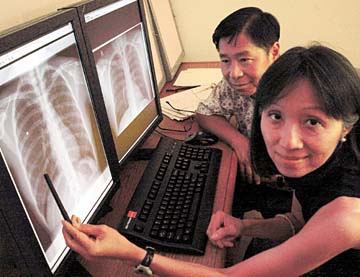
CRAIG T. KOJIMA / CKOJIMA@STARBULLETIN.COM
Dr. Jessie Wing, right, and social worker Clyde Okino review patients' X-rays in the state's renovated tuberculosis clinic.
TB clinic to unveil
high-tech updatesThe Lanakila facility is now among
the most modern in the nation
When the first case of bubonic plague was reported in the territory in 1899, health workers went around the islands and found more tuberculosis cases, said Dr. Jessie Wing, chief of the state TB Control Program.
So in 1901 at Leahi Hospital, the Honolulu Home for Incurables was started to offer care, rest and sunshine for those with TB. With development of drugs, educational programs and screening services, TB deaths in Hawaii fell from one of the nation's highest in 1952 to one of the lowest.
The United States had 751 TB deaths in 2000, with a death rate of 0.3 deaths per 100,000 population. Hawaii had two deaths, with a rate of 0.2 per 100,000 population. There were five TB deaths here in 2001 and two last year.
The TB program moved in 1943 from Leahi Hospital to 1722 Lanakila Ave. and then in 1975 to next door to the Lanakila Health Center built at 1700 Lanakila Ave.
Next Thursday, the state's TB clinic at Lanakila Health Center will show off more than $2 million in cutting-edge renovations and equipment at a grand opening.
Technology changed a lot in 25 years, "but the clinic didn't," said Rachel Blair, TB public health educator. Now it is one of the most advanced public tuberculosis facilities in the country, she said.
COURTEST OF THE STATE TB CONTROL PROGRAM
Before the development of modern TB clinics, trucks were used for examinations.
"It's an unusual clinic here, to have this kind of investment," Wing said. "With state budgets restricted, we had to work with federal dollars to grow."
As a support and referral center for the Pacific, it is also one of the busiest clinics, with about 60,000 patient visits annually, Wing said. The peak occurs in August with required screening for new kindergarten and college students.
The ancient disease, caused by bacteria called Mycobacterium tuberculosis, is spread from one person to another through the air.
Washington, D.C., has a higher TB case rate than Hawaii, but Hawaii had the highest rate of any state the past two years because of immigration, Wing said.
About 150 new cases are identified annually. Of those, 82 percent are foreign-born compared with about 50 percent on the mainland, she said.
Seven paramedical assistants go to different areas every day for "directly observed therapy," making sure patients take required medicines for six months.
"This is how you control drug resistance," Wing said, pointing out that while the TB case rate has stabilized, the number of drug-resistant cases rose to 22 last year from 12 in 2001.
She said the clinic is planning a program to emphasize new national treatment guidelines for TB and drug-resistant TB throughout the state. The Hawaii clinic also is part of a consortium of 22 U.S. and Canadian sites conducting research under CDC grants.
The 10,000-square-foot facility reopened for patients May 27, moving back from temporary locations during the renovations.
"The beauty of the clinic is negative air pressure," Wing said, explaining the air is taken out, cleaned by ultraviolet lights and HEPA filters and is not recirculated.
The clinic does about 20,000 X-rays annually and now has a digital X-ray imaging system that is entirely computerized, which Wing believes is rare for a TB clinic.
"There is a very big difference between now and how it was before," said Orlando Salazar, X-ray technician and supervisor. "It's the greatest thing in the world ... very fast, in milliseconds.
"We're able to make all kinds of changes of benefit to the patient," he said. "In addition to telling the machine what to do, it makes decisions to enhance the picture and use the smallest radiation."
Five years of patient information can be encoded and stored on one videocassette, eliminating the need for a darkroom, chemical processing and X-ray storage, Salazar pointed out.
Eric Tesmer, with Life Science Resources, the X-ray company, said: "Right now, you're at the cutting edge of technology. To be 100 percent filmless is a rarity."
A solarium, wood floors and many windows create a cheerful clinic atmosphere. "We see smiles. People don't mind hanging around," Wing said, describing the previous quarters as "cavernous."

